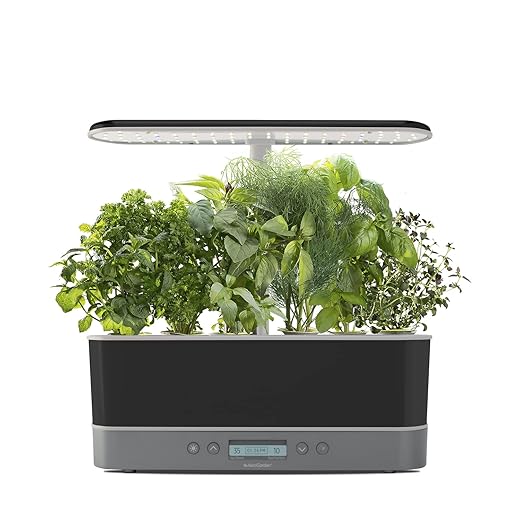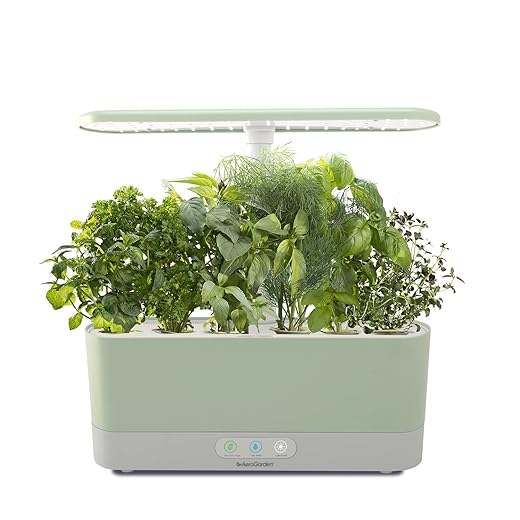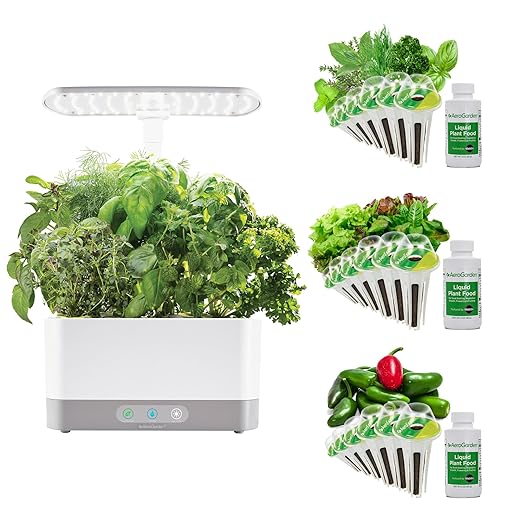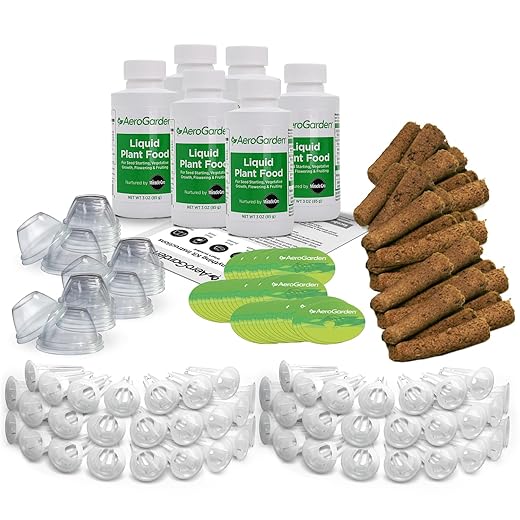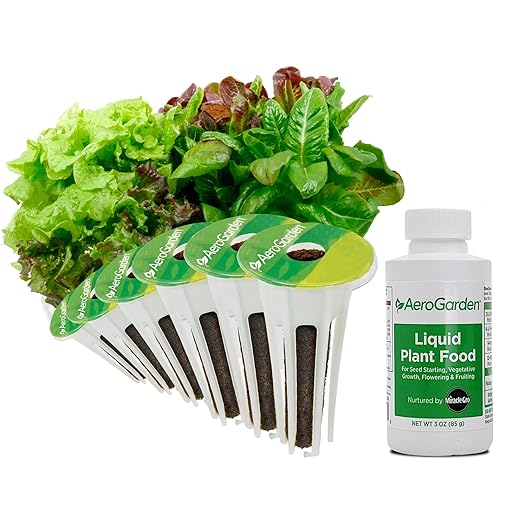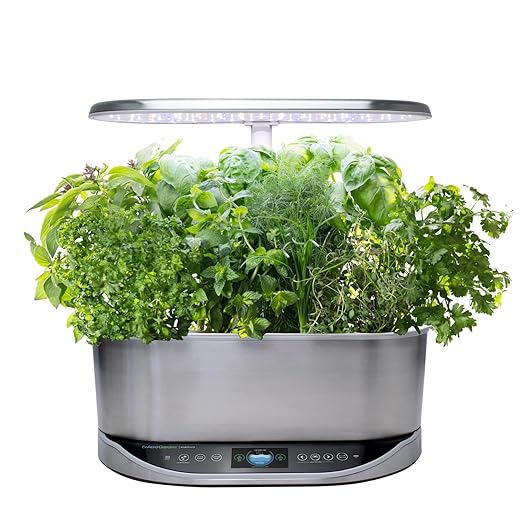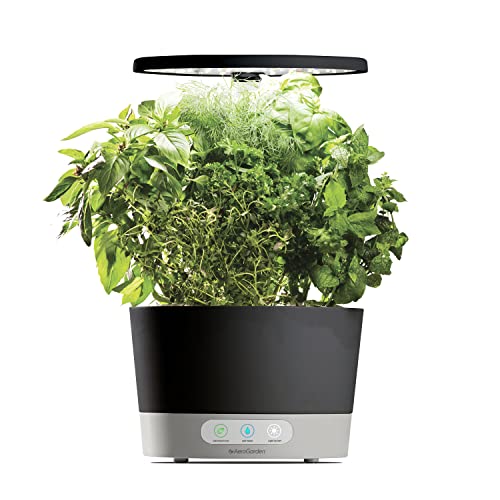AeroGarden is a leading brand in indoor gardening that offers innovative and user-friendly hydroponic systems for growing a variety of plants indoors. Utilizing advanced technology, AeroGarden provides an ideal environment for plants to thrive without the need for soil.
Their hydroponic systems use water, air, and nutrient-rich solutions to nourish the plants’ roots directly. With a wide selection of pre-seeded plant pods, including herbs, vegetables, and flowers, AeroGarden makes indoor gardening accessible to both beginners and experienced gardeners.
Its automated features, customizable settings, and energy-efficient LED grow lights ensure successful growth year-round, allowing individuals to enjoy fresh, homegrown produce regardless of the external climate. AeroGarden’s sleek and compact design makes it a stylish addition to any living space, making indoor gardening an enjoyable and rewarding experience.
Is AeroGarden a US company?
Yes, AeroGarden is a US company. The company was founded in 2002 by Michael Bissonnette, and its headquarters is located in Boulder, Colorado, USA. AeroGarden is a subsidiary of the AeroGrow International, Inc., which specializes in creating innovative indoor gardening solutions using hydroponic technology.
AeroGarden has gained popularity for its high-quality indoor gardening systems, allowing people to grow herbs, vegetables, and flowers year-round in the comfort of their homes. The company’s products are widely available in the United States and have also expanded to international markets, providing indoor gardening solutions to customers worldwide.
What is an AeroGarden and how does it work?
An AeroGarden is an indoor hydroponic gardening system designed to grow plants without the need for soil. It provides a controlled environment that allows individuals to grow a variety of plants, including herbs, vegetables, and flowers, right in their homes or offices. The AeroGarden offers a convenient and user-friendly way to enjoy fresh, homegrown produce year-round.
Here’s how an AeroGarden works:
- Hydroponic System: AeroGarden uses a hydroponic system, which means the plants’ roots grow directly in water, supported by a growing medium. This eliminates the need for soil and simplifies the setup and maintenance process.
- Water Reservoir: The AeroGarden has a built-in water reservoir that holds the water and nutrient solution required for plant growth. The reservoir is typically located at the base of the unit.
- Seed Pods: AeroGarden provides pre-seeded plant pods that come with the appropriate seeds, nutrients, and growing medium. Each pod corresponds to a specific plant variety, such as basil, cherry tomatoes, or lettuce.
- Inserting the Pods: Users need to insert the plant pods into the designated slots or pods tray of the AeroGarden. The pods are designed for easy insertion, and they fit securely into the unit.
- LED Grow Lights: The AeroGarden is equipped with energy-efficient LED grow lights. These lights mimic natural sunlight and provide the necessary spectrum for optimal plant growth. The lights are adjustable in some models, allowing users to raise or lower them as the plants grow.
- Automated Features: AeroGarden often comes with automated features, including a control panel or a digital display that allows users to customize light cycles and receive reminders for water and nutrient refills. Some models may also have Wi-Fi connectivity for remote control and monitoring through a mobile app.
- Nutrient Supply: The AeroGarden delivers essential nutrients to the plants through the water reservoir. The hydroponic system ensures that the plants receive the right amount of nutrients required for healthy growth.
- Continuous Growth: As the plants grow, users can enjoy watching their garden flourish. Depending on the plant variety, users can expect to see results in a matter of weeks, with some plants reaching maturity for harvesting within a few months.
The combination of hydroponic technology, LED grow lights, and automated features makes the AeroGarden a convenient and efficient indoor gardening solution. It simplifies the gardening process, making it accessible to individuals with varying levels of gardening experience. The AeroGarden’s compact design and versatile plant pod options make it a popular choice for those who want to enjoy the benefits of fresh, homegrown produce without the need for an outdoor garden.
What else can I grow in AeroGarden?
In addition to the popular herbs, vegetables, and flowers commonly grown in AeroGarden systems, there are several other plant varieties you can experiment with depending on the model and size of your AeroGarden. Here are some other types of plants you can consider growing:
- Microgreens: Microgreens are young, edible greens harvested at an early stage of growth. They are packed with nutrients and add a burst of flavor to salads, sandwiches, and other dishes. Common microgreens to grow include arugula, kale, radish, and broccoli.
- Salad Greens: Apart from lettuce, you can grow other types of salad greens like spinach, Swiss chard, and baby kale. These greens can be harvested as individual leaves, allowing the plants to continue growing for multiple harvests.
- Herbs (Beyond the Classics): While basil, mint, and parsley are popular choices, you can also try growing less common herbs like cilantro, chives, oregano, thyme, and tarragon.
- Cherry Tomatoes: Some AeroGarden models with larger capacities, such as the Bounty or Farm series, can accommodate cherry tomato plants. Enjoy fresh, homegrown cherry tomatoes from your indoor garden.
- Peppers: Depending on the model, you may be able to grow compact pepper varieties like hot peppers or bell peppers in your AeroGarden.
- Flowering Plants: For aesthetic purposes, you can grow colorful and fragrant flowers such as petunias, pansies, marigolds, and violets in your AeroGarden.
- Strawberries: If you have a larger AeroGarden with enough space, you may be able to grow small strawberry plants, which can produce delicious berries.
- Asian Greens: Varieties like bok choy, tatsoi, and mizuna can add unique flavors to your culinary creations.
- Dwarf Varieties: Look for dwarf or compact varieties of vegetables and herbs that are suitable for indoor gardening and can thrive in the limited space of an AeroGarden.
When selecting plants to grow in your AeroGarden, consider the available space, light conditions, and the specific model you have. Read the plant descriptions and follow the recommended growing guidelines to ensure success. Experimenting with different plant varieties can add diversity to your indoor garden and provide you with fresh, homegrown produce and herbs year-round.
Where is the best place to put an AeroGarden?
The best place to put an AeroGarden is in a location that meets the following criteria:
- Access to Light: AeroGardens come with built-in LED grow lights that provide the necessary light spectrum for plant growth. However, it’s still beneficial to place the AeroGarden near a source of natural light, such as a window. This can supplement the LED lights and provide additional brightness to support plant growth.
- Stable Surface: Choose a stable and level surface to place your AeroGarden. The unit should be able to support the weight of the water reservoir, plants, and any additional accessories you may have.
- Proximity to a Power Source: AeroGardens require electricity to power the LED grow lights and, in some models, the water pump. Ensure the chosen location is close to an electrical outlet.
- Temperature and Climate: Avoid placing the AeroGarden in extreme temperature or climate conditions, such as near a heating vent or drafty window. Stable room temperature is ideal for plant growth.
- Convenience and Accessibility: Consider placing the AeroGarden in a location that is easily accessible for daily tasks like watering, pruning, and harvesting. This makes it more convenient for you to care for your plants.
- Avoid Direct Sunlight: While it’s beneficial to have access to natural light, avoid placing the AeroGarden in direct sunlight. Direct sunlight can cause excessive heat, potentially harming the plants and interfering with the performance of the LED grow lights.
- Visibility and Aesthetics: Consider placing the AeroGarden in a location where you can easily enjoy and appreciate your indoor garden. It can also be a decorative addition to your living space.
Common locations for an AeroGarden include kitchen countertops, dining room tables, sideboards, or any other well-lit area in your home. Just make sure that the space you choose meets the essential criteria for the optimal growth of your plants and fits well with your daily routine. By placing your AeroGarden in the right location, you can create a beautiful, functional, and rewarding indoor gardening experience.
Can you use soil in AeroGarden?
AeroGarden is designed to work with their proprietary seed pods and a hydroponic system that uses water, air, and nutrient-rich solutions to grow plants without the need for soil. The hydroponic setup allows the plant roots to directly access the water and nutrients, providing an efficient and controlled growing environment.
Using traditional soil in an AeroGarden is not recommended and may not yield successful results. The AeroGarden’s hydroponic system is calibrated to work with their pre-seeded pods, which include a specific growing medium optimized for plant growth and nutrient delivery. Regular soil may not be compatible with the AeroGarden’s water delivery system and could cause clogging or other issues.
However, if you prefer to grow plants using soil, there are other indoor gardening systems or methods better suited for that purpose. You can consider using traditional potted plants, container gardening, or setting up a separate indoor soil-based garden to accommodate your planting preferences.
If you’re interested in experimenting with different growing mediums and methods, you may also explore setting up a DIY hydroponic system. This way, you can customize the setup to include soil or other growing media while still benefitting from the hydroponic principles of water-based nutrient delivery.
Always follow the manufacturer’s guidelines and recommendations when using any indoor gardening system, including the AeroGarden, to ensure successful plant growth and avoid potential issues.
Can you use regular seeds with AeroGarden?
AeroGarden is designed to work with their proprietary seed pods, and using regular seeds (non-AeroGarden branded seeds) directly in the system is not officially supported. The AeroGarden’s hydroponic system is calibrated to work specifically with their pre-seeded pods, which include the necessary growing medium and nutrients tailored for optimal growth.
Using regular seeds in an AeroGarden may not yield the best results, as the hydroponic system is not optimized for them. Regular seeds may not have the same compatibility with the AeroGarden’s water delivery system and could result in inconsistent or poor germination and growth.
However, if you still wish to experiment with different seeds in a hydroponic system similar to the AeroGarden, you can consider setting up a DIY hydroponic setup. There are various DIY hydroponic methods that can accommodate regular seeds, such as deep water culture (DWC), nutrient film technique (NFT), or ebb and flow systems.
In a DIY hydroponic system, you have more control over the growing conditions and nutrient solutions, allowing you to customize the setup to suit the specific needs of the seeds you want to grow.
Keep in mind that using regular seeds in a DIY hydroponic system requires more expertise and hands-on management compared to the user-friendly, automated AeroGarden. If you prefer the convenience and ease of use provided by the AeroGarden, it’s recommended to use their official seed pods specifically designed for their system.
Can I run my AeroGarden without water?
No, you should not run your AeroGarden without water. Adequate water supply is essential for the plants to grow and thrive in an AeroGarden. The AeroGarden’s hydroponic system relies on water to deliver nutrients to the plant roots and provide the necessary moisture for plant growth.
Running the AeroGarden without water can lead to several issues:
- Plant Dehydration: Without water, the plants in the AeroGarden will quickly become dehydrated, leading to wilting, stunted growth, and ultimately plant death.
- Nutrient Deprivation: The hydroponic system depends on water to carry nutrients to the plant roots. Depriving the plants of water means they won’t receive the essential nutrients needed for healthy growth.
- System Damage: Running the AeroGarden without water can potentially damage the water pump or other components of the hydroponic system, as the pump requires water to function properly.
- Plant Stress: Plants subjected to water deprivation will experience stress, which weakens their overall health and makes them more susceptible to diseases and pests.
Proper water management is crucial for successful indoor gardening in an AeroGarden. Follow the manufacturer’s guidelines for filling the water reservoir, and ensure the water level remains consistent to support the plants’ needs. Additionally, regularly monitor the water level and nutrient supply to maintain a healthy growing environment for your plants.
How often does AeroGarden need water?
The frequency of watering an AeroGarden depends on several factors, including the specific model, the size of the water reservoir, the number and type of plants being grown, and the environmental conditions. AeroGarden models have different water reservoir capacities, which can impact how often you’ll need to add water to the system.
As a general guideline:
- Monitor Water Level: Regularly check the water level in the AeroGarden’s water reservoir to ensure it doesn’t run too low. Some models have water level indicators to make this process easier.
- Young Seedlings: During the early stages of plant growth, the water consumption may be lower. Still, it’s crucial to maintain an adequate water level to ensure the seedlings get enough moisture.
- Mature Plants: As plants grow and develop, their water needs increase. You may need to check and refill the water reservoir more frequently as the plants get larger and start consuming more water.
- Environmental Factors: Factors such as indoor temperature, humidity levels, and the type of plants you are growing can affect how quickly the water is used up. In drier environments or when growing water-intensive plants, you may need to refill the water reservoir more often.
- Plant Stage: The growth stage of your plants can also impact their water requirements. For example, plants in the flowering or fruiting stage may need more water than plants in the vegetative growth phase.
As a general rule, it’s a good idea to check the water level in your AeroGarden every few days. If the water level is significantly lower or you notice that the water pump is running more frequently, it’s a clear indication that it’s time to refill the water reservoir.
Remember that maintaining a consistent water level is crucial for the health and growth of your plants in the AeroGarden. Avoid letting the water reservoir run dry, as this can lead to stress on the plants and negatively impact their growth. On the other hand, overfilling the reservoir can also be detrimental, as it may lead to root rot or other issues.
By monitoring the water level and adjusting your watering schedule as needed, you can ensure your AeroGarden plants receive the optimal amount of moisture for healthy growth and development.
Can you grow houseplants in an AeroGarden?
Yes, you can grow certain houseplants in an AeroGarden, depending on the model and size of the unit. While AeroGarden is primarily known for growing herbs, vegetables, and flowers, some houseplants can thrive in the hydroponic system with appropriate care and consideration.
Here are some houseplants that are suitable for growing in an AeroGarden:
- Peace Lily (Spathiphyllum): Peace lilies are popular houseplants known for their attractive white flowers and air-purifying qualities. They can do well in an AeroGarden with enough space to accommodate their mature size.
- Spider Plant (Chlorophytum comosum): Spider plants are low-maintenance and air-purifying houseplants that can thrive in an AeroGarden with ample light.
- Pothos (Epipremnum aureum): Pothos is a trailing houseplant that can grow well in a hydroponic environment like an AeroGarden, as long as it has adequate space to trail.
- Philodendron: Certain varieties of philodendron, such as the heartleaf philodendron (Philodendron hederaceum), can be suitable for an AeroGarden setup.
- African Violet (Saintpaulia): African violets are beautiful flowering houseplants that can thrive in an AeroGarden with the right light conditions.
When selecting houseplants for your AeroGarden, consider their mature size and growth habits, as some houseplants can outgrow the available space in the unit. It’s also essential to ensure that the light and nutrient requirements of the chosen houseplants align with the AeroGarden’s capabilities.
Remember to check the specific model and size of your AeroGarden to determine the available space and lighting options. Additionally, consider the plant’s individual needs, and be prepared to adjust the light cycle and nutrient delivery accordingly to support healthy growth.
Does AeroGarden need sunlight?
Yes, AeroGarden systems do need access to light, but they do not necessarily require direct sunlight. AeroGardens are equipped with built-in LED grow lights that provide the necessary light spectrum for plant growth. These LED lights mimic the spectrum of natural sunlight, making them an essential component of the AeroGarden’s hydroponic system.
The LED grow lights in the AeroGarden are designed to provide the right intensity and spectrum of light needed for plants to perform photosynthesis and grow successfully. They deliver the essential wavelengths of light required for various stages of plant growth, including vegetative growth and flowering.
The advantage of using LED grow lights in the AeroGarden is that they are energy-efficient and can be tailored to specific plant varieties’ light requirements. Additionally, they enable you to grow plants in indoor environments where natural sunlight may be limited or insufficient for proper plant growth.
While AeroGarden units can be placed in rooms with ambient light, it’s essential to position the unit in a location where the LED grow lights can effectively reach the plants. Avoid placing the AeroGarden in direct sunlight, as excessive sunlight exposure could lead to overheating and may not be necessary since the LED lights are optimized for plant growth.
In summary, while AeroGardens don’t need direct sunlight, they do require access to LED grow lights to ensure healthy plant growth and development. The LED lights provide the necessary light spectrum for photosynthesis, making it possible to grow plants successfully indoors year-round.
How many plants can you grow in AeroGarden?
The number of plants you can grow in an AeroGarden depends on the specific model and size of the unit. AeroGarden offers various models with different pod capacities to accommodate different plant quantities. The number of plants that can be grown simultaneously in an AeroGarden typically ranges from 3 to 24, depending on the model.
Here are some common AeroGarden models and their pod capacities:
- AeroGarden Sprout: This compact model usually accommodates 3 to 6 plant pods.
- AeroGarden Harvest: The Harvest model can hold 6 to 12 plant pods, depending on the variant (Harvest, Harvest Elite, or Harvest 360).
- AeroGarden Bounty: The Bounty models offer larger capacities, with 9 to 24 plant pods, depending on the variant (Bounty, Bounty Elite, or Bounty 360).
- AeroGarden Farm: The Farm models are designed for higher yields and can hold up to 12, 24, or 36 plant pods, depending on the Farm model size (Farm 12, Farm 24, or Farm 36).
It’s important to consider the available space in your home and your gardening needs when choosing the right AeroGarden model. If you have limited space or want to start with a smaller setup, models like the Sprout or Harvest could be suitable. If you have more space and want to grow a larger variety of plants, the Bounty or Farm models may be more appropriate.
Remember that the number of plants you grow also depends on the plant varieties you choose and their space requirements. Some plants, like tomatoes or peppers, may require more space and be better suited for larger AeroGarden models, while herbs and leafy greens are ideal for smaller setups.
Before purchasing an AeroGarden, check the specific model’s pod capacity to ensure it meets your indoor gardening goals and the number of plants you wish to grow simultaneously.
How many times can you harvest AeroGarden?
The number of times you can harvest from an AeroGarden can vary depending on several factors, including the plant varieties you grow, their growth rate, and the specific model of your AeroGarden. Some herbs and leafy greens can be harvested multiple times, while other plants may be harvested once for their main yield.
Here are some general guidelines for harvesting from an AeroGarden:
- Herbs: Many herbs, such as basil, mint, parsley, and dill, are considered “cut-and-come-again” plants. This means you can harvest a portion of the leaves without harming the plant, and it will continue to produce new growth. You can usually harvest herbs several times throughout their growth cycle.
- Leafy Greens: Similar to herbs, some leafy greens like lettuce, arugula, and spinach can be harvested repeatedly by cutting the outer leaves while allowing the center to continue growing.
- Fruiting Plants: For plants that produce fruits, such as cherry tomatoes or peppers, you can expect one main harvest when the fruits reach maturity. Some plants may produce additional yields if they are long-bearing varieties.
- Flowers: If you’re growing flowering plants, such as petunias or pansies, you can enjoy their blooms for an extended period, depending on the plant’s specific flowering cycle.
The duration of each harvest cycle depends on the plant’s growth rate and the time it takes for the plants to mature and produce new growth. Some herbs and leafy greens can be harvested every few weeks, while others may have longer cycles.
To maximize the harvest potential of your AeroGarden, consider staggered planting, where you start new plant pods at different times. This way, you can have a continuous supply of fresh produce throughout the year.
Always follow proper harvesting techniques to ensure the plants remain healthy and productive. As the AeroGarden is designed for indoor gardening and continuous growing, you can enjoy multiple harvests from your plants, making it a rewarding and efficient way to have homegrown produce at your fingertips.
Can I reuse AeroGarden pods?
AeroGarden does not officially recommend or support the reuse of their pre-seeded pods. AeroGarden’s proprietary seed pods are designed for single-use, and the growing medium inside them is specifically formulated for optimal germination and plant growth during the first use.
Reusing AeroGarden pods could lead to several potential issues:
- Contamination: After one use, the growing medium in the pods may become contaminated with plant debris, roots, or pathogens, which could affect the success of subsequent plantings.
- Nutrient Depletion: The nutrients provided in the pre-seeded pods are meant to support the initial growth of the plants. Reusing the pods may result in depleted nutrients, negatively impacting the growth of new plants.
- Uneven Growth: The roots of previous plants may have left behind an uneven or compacted growing medium, making it challenging for new seeds to establish healthy root systems.
- Disease Transmission: If the previous plants suffered from any diseases, reusing the pods could potentially spread pathogens to new plantings.
To ensure the best results and prevent potential issues, it is recommended to use fresh, new AeroGarden seed pods for each planting cycle. This will provide your new seeds with the best possible start and increase the likelihood of successful germination and growth.
If you’re interested in reusing pods or experimenting with different growing mediums and seeds, you may consider setting up a DIY hydroponic system. This way, you have more control over the growing medium and nutrient solution, allowing you to customize the setup and reuse containers as needed. However, keep in mind that DIY hydroponic systems require more hands-on management and may not offer the same user-friendly experience as the AeroGarden’s pre-seeded pods.
Is the AeroGarden worth it?
Whether or not the AeroGarden is worth it depends on your individual preferences, gardening goals, and lifestyle. The AeroGarden offers several benefits that make it a valuable and enjoyable indoor gardening solution for many people, but it may not be the best fit for everyone. Consider the following factors to determine if the AeroGarden is worth it for you:
Pros of AeroGarden:
- Convenience: AeroGarden provides a convenient and accessible way to grow fresh herbs, vegetables, and flowers indoors year-round, without the need for outdoor gardening space.
- Space-Saving: Its compact design makes it ideal for small living spaces, apartments, and kitchens, allowing you to grow plants in areas with limited space.
- Rapid Growth: The hydroponic system and LED grow lights promote faster and healthier plant growth, allowing you to enjoy homegrown produce in a short time.
- User-Friendly: AeroGarden is easy to set up and use, making it suitable for both experienced and novice gardeners. The pre-seeded pods and automated features simplify the growing process.
- Continuous Harvest: Certain plants can be harvested repeatedly, providing a continuous supply of fresh herbs and vegetables.
- Customizable Features: Some models offer customizable light cycles and smart features through mobile apps, allowing you to tailor the growing conditions to specific plant varieties.
Cons of AeroGarden:
- Cost: The initial investment in an AeroGarden and the ongoing expenses for proprietary seed pods, nutrient refills, and replacement parts may be higher than traditional gardening methods.
- Limited Plant Choices: AeroGarden’s seed pod selection may not include all the plant varieties you may want to grow, limiting your gardening options.
- Electricity Consumption: The LED grow lights require electricity, which may increase your energy consumption.
- Dependency on Manufacturer: AeroGarden relies on its proprietary seed pods and nutrient solutions, limiting the freedom to experiment with different plants and growing media.
- Maintenance: Regular maintenance, such as monitoring water levels, nutrient refills, and cleaning, is required to ensure the system’s optimal performance.
If the convenience, accessibility, and joy of homegrown produce outweigh the costs and limitations for you, then the AeroGarden can be a worthwhile investment. It offers a unique and rewarding indoor gardening experience, allowing you to have fresh herbs and vegetables at your fingertips year-round.
Before making a decision, consider your gardening preferences, available space, budget, and the types of plants you wish to grow. Additionally, read customer reviews and testimonials to gain insights into real-world experiences with the AeroGarden model you are interested in. By carefully evaluating these factors, you can determine if the AeroGarden aligns with your gardening goals and if it’s worth it for you.
Factors to consider when buying Aerogarden
When buying an AeroGarden, there are several important factors to consider to ensure you choose the right model that suits your gardening needs and preferences. Here are the key factors to keep in mind:
- Size and Capacity: AeroGarden models come in various sizes with different pod capacities. Consider how much space you have available and how many plants you want to grow simultaneously. Smaller models may be suitable for compact spaces, while larger models offer more growing opportunities.
- Plant Selection: Check the available seed pod options for the AeroGarden model you are considering. Ensure that the plants you want to grow are compatible with the available pod varieties. Some models offer more diverse plant selections than others.
- LED Light Type and Intensity: LED grow lights are a critical component of the AeroGarden. Check the type of LED lights used (full-spectrum or specific spectrums) and their intensity. Models with adjustable light settings allow you to customize light cycles to suit different plant varieties.
- Automated Features: Consider the level of automation and control offered by the AeroGarden. Some models come with Wi-Fi connectivity and smart features, allowing you to control light cycles and receive gardening tips through a mobile app.
- Water Pump: Some AeroGarden models come with a water pump to circulate the nutrient solution, promoting better plant growth. Check if the model you are interested in includes a water pump and how it operates.
- Power Consumption: LED grow lights require electricity, so check the power consumption of the AeroGarden model you are considering to ensure it aligns with your energy usage preferences.
- Price and Budget: AeroGarden models vary in price based on size, features, and capabilities. Set a budget that aligns with your requirements and choose a model that offers the best value for your investment.
- Replacement Parts and Maintenance: Research the availability and cost of replacement parts, such as grow bulbs, water pumps, and nutrient solutions. Also, consider the maintenance requirements and ease of cleaning for the model you select.
- Customer Reviews: Read customer reviews and testimonials to gain insights into real-world experiences with the AeroGarden model you are interested in. Customer feedback can provide valuable information on performance, reliability, and satisfaction.
- Warranty and Customer Support: Check the warranty coverage and the manufacturer’s customer support services. A reliable warranty and responsive customer support can provide peace of mind in case of any issues or concerns.
By carefully considering these factors, you can make an informed decision and choose the AeroGarden model that best suits your indoor gardening goals and preferences.
How long will an AeroGarden last?
The lifespan of an AeroGarden can vary depending on several factors, including the model, usage, maintenance, and the quality of its components. AeroGarden units are generally designed to be durable and long-lasting, providing users with years of indoor gardening enjoyment. However, the exact lifespan can differ based on individual circumstances.
With proper care and maintenance, an AeroGarden can last for several years. Some components, such as the LED grow lights, can have a longer lifespan and may not need replacement for a considerable amount of time. Other parts, like the water pump (if applicable), may require occasional maintenance or replacement over the years.
To help prolong the life of your AeroGarden, consider the following tips:
- Regular Cleaning: Keep the AeroGarden clean by wiping down surfaces, removing debris, and maintaining cleanliness in the water reservoir.
- Proper Watering and Nutrient Management: Ensure the water reservoir is always filled with water and that you provide the appropriate nutrient solution according to the plant’s needs.
- LED Light Care: If the AeroGarden has adjustable LED grow lights, avoid excessive adjustments, and use the lights according to the recommended guidelines.
- Avoid Overloading: Follow the manufacturer’s recommendations for the number of plant pods suitable for your specific AeroGarden model. Overloading the unit may put strain on the components.
- Monitor Components: Periodically inspect the various components for signs of wear, damage, or malfunction. Address any issues promptly to prevent further damage.
- Seasonal Use or Storage: If you don’t plan to use the AeroGarden for an extended period, store it properly by cleaning it and removing any water from the reservoir. This can help prevent potential issues caused by stagnant water.
- Follow Instructions: Always adhere to the manufacturer’s instructions, guidelines, and safety precautions to ensure proper usage and care.
It’s important to note that advancements in technology and product updates may lead to improvements in AeroGarden models’ durability and performance. For the most accurate and up-to-date information on the expected lifespan of a specific AeroGarden model, it’s best to refer to the product’s official documentation or contact the manufacturer directly.
How often do I feed my AeroGarden?
The frequency of feeding your AeroGarden depends on the specific model, the plant varieties you are growing, and the growth stage of the plants. AeroGarden systems utilize a hydroponic system where plants receive their nutrients through the water. Therefore, it’s essential to maintain an appropriate nutrient solution to support healthy plant growth.
Here are some general guidelines for feeding your AeroGarden:
- Initial Filling: When setting up your AeroGarden, you’ll need to fill the water reservoir with the appropriate amount of water and nutrient solution according to the manufacturer’s instructions.
- Top-Up Water: Regularly monitor the water level in the reservoir and top it up as needed. As the plants absorb water, the level will decrease over time.
- Nutrient Refill: AeroGarden models typically come with nutrient solution bottles, and the manufacturer will provide guidelines on when and how much nutrient solution to add to the water. This is usually required every 1 to 2 weeks, but it can vary depending on the plant varieties and the model of your AeroGarden.
- Plant Growth Stage: Adjust the nutrient solution according to the growth stage of your plants. Young seedlings and newly sprouted plants require less concentrated nutrient solutions, while mature plants with significant growth may require stronger nutrient mixes.
- Drain and Refill: Periodically, it’s a good idea to drain and refill the water reservoir with fresh water and nutrient solution to ensure optimal nutrient delivery to the plants.
- Monitor pH Levels: For certain plant varieties, you may need to monitor and adjust the pH levels of the nutrient solution to ensure the plants can properly absorb the nutrients.
Always refer to the user manual and guidelines provided by the manufacturer for your specific AeroGarden model. Different models may have slightly different requirements, and following the manufacturer’s recommendations will help ensure the best results for your indoor garden.
Additionally, keep an eye on your plants for any signs of nutrient deficiencies or overfeeding, such as yellowing leaves or nutrient burn. Adjust the nutrient solution accordingly based on the plants’ needs and the feedback from their growth. With proper nutrient management, you can enjoy healthy and thriving plants in your AeroGarden.
How do I clean my AeroGarden every month?
Cleaning your AeroGarden regularly is essential for maintaining a healthy and productive indoor garden. Here’s a step-by-step guide on how to clean your AeroGarden approximately once a month:
- Unplug the AeroGarden: Before starting any cleaning procedures, unplug the AeroGarden from the power source to ensure safety.
- Remove Plant Debris: Gently remove any dead leaves, stems, or plant debris from the surface of the AeroGarden. This helps prevent mold and algae growth and keeps the garden tidy.
- Clean the Water Reservoir: Drain the water reservoir completely. Remove any remaining water and clean the reservoir with warm, soapy water. Rinse thoroughly to remove any soap residue.
- Wipe Down the Unit: Use a damp cloth or sponge to wipe down the exterior surfaces of the AeroGarden, including the base, control panel, and grow deck. Avoid getting water into any electronic components.
- Clean the Pump and Filter: If your AeroGarden model has a water pump and filter, it’s essential to clean them regularly. Check the manufacturer’s instructions for specific guidance on cleaning the pump and filter. Typically, the pump can be removed and cleaned with warm, soapy water, and the filter can be rinsed or replaced as needed.
- Check the LED Lights: Inspect the LED lights for any dust or debris that may have accumulated. If necessary, use a soft, dry cloth or a microfiber cloth to gently clean the lights. Avoid touching the lights while they are on or plugged in.
- Refill the Water Reservoir: After cleaning, refill the water reservoir with fresh water and the appropriate nutrient solution according to the manufacturer’s guidelines.
- Check for Any Issues: While cleaning, take the opportunity to check for any signs of wear, damage, or malfunction in the AeroGarden components. Address any issues promptly, and if necessary, contact the manufacturer for support or replacement parts.
- Restart the AeroGarden: Once you have completed the cleaning process, plug the AeroGarden back into the power source and turn it on.
- Resume Normal Operation: Set your AeroGarden to its usual light and nutrient schedule, and continue caring for your plants as usual.
Regular cleaning helps ensure the optimal performance of your AeroGarden and creates a clean and healthy environment for your plants to thrive. By following these cleaning steps approximately once a month, you can enjoy a successful and rewarding indoor gardening experience with your AeroGarden.
Final Thoughts
In conclusion, the AeroGarden is an innovative and user-friendly indoor gardening system that allows individuals to grow a variety of herbs, vegetables, and flowers in the comfort of their own homes, regardless of the season or outdoor conditions. With its hydroponic technology and LED grow lights, the AeroGarden provides an optimal environment for rapid and healthy plant growth, allowing users to enjoy fresh, homegrown produce and herbs throughout the year.
The AeroGarden’s compact and space-saving design makes it suitable for small living spaces, apartments, and kitchens, while its automated features and pre-seeded pods make it accessible to both experienced and novice gardeners. The system offers the convenience of a controlled environment with adjustable light cycles and nutrient delivery, reducing the risks associated with traditional gardening methods.
While the AeroGarden’s proprietary seed pods and nutrient solutions may limit some users’ choices, the system offers a wide range of plant varieties to cater to different tastes and culinary preferences. Users can experiment with various plants, including herbs, leafy greens, cherry tomatoes, and even certain flowering plants.
However, it’s essential to consider factors like the size and capacity of the AeroGarden, the type of LED lights, the level of automation, and budget constraints when choosing the right model. Additionally, users should be aware of the costs associated with replacement parts, nutrient refills, and electricity consumption for LED lights.
Ultimately, the AeroGarden provides an enjoyable and rewarding indoor gardening experience, enabling users to grow their own fresh and nutritious produce, enhance their culinary creations, and connect with nature in an urban setting. By carefully considering the factors and understanding the pros and cons, individuals can make an informed decision and select the AeroGarden model that best suits their needs and lifestyle.
As with any gardening endeavor, consistent care and attention to the plants’ needs are crucial for successful and fruitful growth. With proper maintenance, the AeroGarden can serve as a beautiful and functional addition to any home, bringing the joy of gardening right to your fingertips.
You May Also Like These Deals!
How does the smart garden work?
The Click and Grow Smart Garden is a cutting-edge and...
Read MoreHow do I style my outdoor patio?
An outdoor patio is an extension of a living space...
Read MoreGardening Tool Black Friday Deals
Outside, it may be frigid, but inside, things are heating...
Read MoreProducts recommended in the post contain affiliate links. We may receive a commission when you buy something through our posts.
Why Trust Us
You will find what you are looking for at Black Friday Weeks. From classic to luxury brands, you'll find both. We will help you to select appliances that fit your needs, budget and lifestyle. Whether you want to stop by to learn more — or plan to make a major purchase — we’ll treat you like family and assist you every step of the way. Shop with us today to receive friendly and experienced help along the way.


